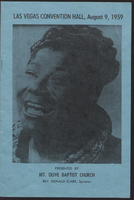Search the Special Collections and Archives Portal
Search Results
Hughes Aviation retirement presentation, 1976 April 02
Level of Description
File
Archival Collection
Frank Mitrani Photographs
To request this item in person:
Collection Number: PH-00332
Collection Name: Frank Mitrani Photographs
Box/Folder: Box 41
Collection Name: Frank Mitrani Photographs
Box/Folder: Box 41
Archival Component
Lazwell, Paulette, Hughes Aviation, 1975 August 11
Level of Description
File
Archival Collection
Frank Mitrani Photographs
To request this item in person:
Collection Number: PH-00332
Collection Name: Frank Mitrani Photographs
Box/Folder: Box 43
Collection Name: Frank Mitrani Photographs
Box/Folder: Box 43
Archival Component
Finn, Brooke, Hughes Airlines, 1976 March 04
Level of Description
File
Archival Collection
Frank Mitrani Photographs
To request this item in person:
Collection Number: PH-00332
Collection Name: Frank Mitrani Photographs
Box/Folder: Box 41
Collection Name: Frank Mitrani Photographs
Box/Folder: Box 41
Archival Component
Westgate, Carol, Hughes Airlines, 1977 June 13
Level of Description
File
Archival Collection
Frank Mitrani Photographs
To request this item in person:
Collection Number: PH-00332
Collection Name: Frank Mitrani Photographs
Box/Folder: Box 41
Collection Name: Frank Mitrani Photographs
Box/Folder: Box 41
Archival Component
Hughes Airport DC-8 plane, 1973 January 03
Level of Description
File
Archival Collection
Frank Mitrani Photographs
To request this item in person:
Collection Number: PH-00332
Collection Name: Frank Mitrani Photographs
Box/Folder: Box 56
Collection Name: Frank Mitrani Photographs
Box/Folder: Box 56
Archival Component
Hughes Aviation gift shop, 1974 July 23
Level of Description
File
Archival Collection
Frank Mitrani Photographs
To request this item in person:
Collection Number: PH-00332
Collection Name: Frank Mitrani Photographs
Box/Folder: Box 24
Collection Name: Frank Mitrani Photographs
Box/Folder: Box 24
Archival Component
Hughes Aviation paraplegic arrival, 1976 December 03
Level of Description
File
Archival Collection
Frank Mitrani Photographs
To request this item in person:
Collection Number: PH-00332
Collection Name: Frank Mitrani Photographs
Box/Folder: Box 38
Collection Name: Frank Mitrani Photographs
Box/Folder: Box 38
Archival Component
Hughes Aviation airport facilities, 1974 March 19
Level of Description
File
Archival Collection
Frank Mitrani Photographs
To request this item in person:
Collection Number: PH-00332
Collection Name: Frank Mitrani Photographs
Box/Folder: Box 10
Collection Name: Frank Mitrani Photographs
Box/Folder: Box 10
Archival Component
Howard Hughes; Hughes's lawyer T. A. Slack; John B. Parkinson, representative of the national Advisory Committee for Aeronautics; Edward Schwartz, former member of the Air Force Evaluation Board; E. A. Peterman; and Glen Odekirk, an executive of the Hughes's Plant, 1947 November 08
Level of Description
File
Archival Collection
Howard Hughes Public Relations Photograph Collection
To request this item in person:
Collection Number: PH-00373
Collection Name: Howard Hughes Public Relations Photograph Collection
Box/Folder: Folder 28
Collection Name: Howard Hughes Public Relations Photograph Collection
Box/Folder: Folder 28
Archival Component
Pagination
Refine my results
Content Type
Creator or Contributor
Subject
Archival Collection
Digital Project
Resource Type
Year
Material Type
Place
Language
Records Classification

